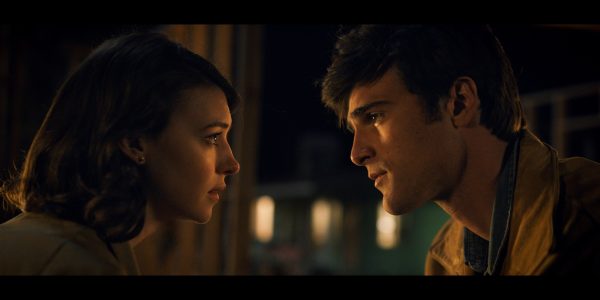
Basing their new opera on the 1940 novella by Adolfo Bioy Casares, Stewart Copeland and Jonathan Moore’s “The Invention of Morel” opened last Saturday in Long Beach and concludes this weekend. It’s a co-commission by Chicago Opera Theater, where it premiered last year, and Long Beach Opera, where it’s making its West Coast debut.
Bioy Casares is best known as having been a close collaborator with Jorge Luis Borges, and Stewart Copeland is best known for having been a close collaborator with Andy Summers and Sting. Copeland played drums for The Police, and has subsequently composed scores for film and worked up a few operas: “The Invention of Morel” is his fifth. Stage director and co-librettist Moore has a line of impressive credentials as well.
While it helps to have read the novella, which is only 90 pages or so, the 90 minutes or so opera should be considered apart from the original, highly-praised story. What we need to ask is, Does it stand on its own two feet?
In the broadest terms, a fugitive (no background is given) is told about an island (the “only one possible place for a fugitive like you”) by an Italian rug merchant living in Calcutta by the name of Ombrellieri. It turns out to be a small, uninhabited tropical isle and the fugitive is there for 100 days before the arrival of tourists, or perhaps we could say the guests of a certain Morel (Nathan Granner). “The fact that their clothes are from another era indicates that they are a group of eccentrics.” That sentence is from the book, and if one reads it carefully it doesn’t actually say the visitors are from another era, only that they’re dressed that way.

The Fugitive spies on the weeklong daytrippers, but they seem to have no interest in him, even when he develops an infatuation for the Louise Brooks-lookalike Faustine (Jamie Chamberlin). In fact, even when he approaches her she seems to ignore him and/or to pretend he’s not there.
Though in theory uninhabited, the island has three or four structures, the main one being a “museum” that is perhaps closer to a hotel… or a sanitorium.
“The Invention of Morel” has a lively, percolating score performed by a 16-piece orchestra, conducted by Long Beach Opera’s artistic director Andreas Mitisek. The music is dramatic, often cinematic, and perhaps we could say it underlines the psychological rather than pleasantly culminating in melodic arias or tunes the viewer can whistle on the way home.

The effect is no doubt enhanced for those looking straight on, a perspective I did not have, being seated at such an extreme angle that my sightline led to the seats opposite, a bow shot across the apron of the stage, as it were. It was arguably one of the worst vantage points in the house and no doubt affected my enjoyment of the performance.
But to continue…
Something is amiss, and the viewer may entertain several hypotheses, such as the Fugitive being somewhat of a ghost, sort of like Bruce Willis in “The Sixth Sense,” or, conversely, the partygoers being reminiscent of the guests in Thomas Adès’ recent opera, “The Exterminating Angel,” which is based upon, and thus brings to mind another Buñuel film, “The Discreet Charm of the Bourgeoisie,” both movies with captive dinner parties. If there is a problem, it’s that the viewer may not know which path to mentally pursue.
We also have to doubt the utter sanity of the Fugitive himself, hiding out as he does in mosquito-infested swampy waters. After all, in the novella we do see his confusion and he even has explicit doubts as to whether he’s alive or dead (and so, back to the “Sixth Sense” scenario).

But if the opera is considered science-fiction as well as surrealism, it’s because this Moreau-Morel character has created a machine, a kind of perpetual motion device referred to here as the Green Machine that is kept in operation by the tides and is assumed to be eternal. Naturally, although this wasn’t an issue or a concern when Bioy Casares wrote his story, the rising seas will soon enough put it out of commission.
And what does the machine do? It has preserved a week on the island, recorded it, and it’s a loop that plays over and over in a kind of superduper virtual reality. This explains plenty of other things, doesn’t it, especially the human (non)interaction between the Fugitive and the guests, who emerge periodically from backstage to chatter among themselves on a stage that seems too small to contain the gamut of emotions they could be expressing.
The Fugitive longs to be a part of this eternal loop (he wants to get in on the picture, as it were). And so how does he intend to enable his everlasting love for Faustine? Does he make a Faustian bargain? You’ll just need to see for yourself, if you’re interested.
The result is an enigmatic work, rather accessible, even enjoyable in its parts, but lacking a cohesiveness or concerted impact. The ingredients appear to be in place, but do they move or inspire us? And is there any one character or situation that pulls us in? My answer to that would be close, but no cigar.
The Invention of Morel is being performed Saturday at 7:30 and Sunday at 2:30 p.m. in the Beverly O’Neill Theater (formerly the Center Theater), 300 E. Ocean Blvd., Long Beach. A pre-opera talk takes place one hour before each performance. Tickets, $49 to $150. Call (562) 470-7464 or go to longbeachopera.org. ER










